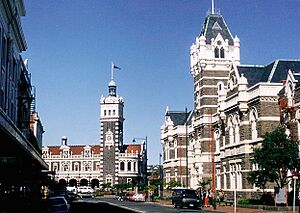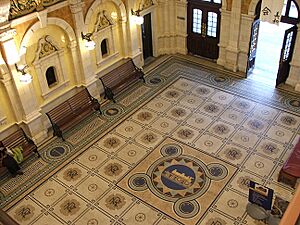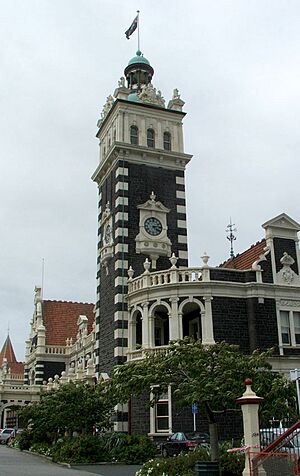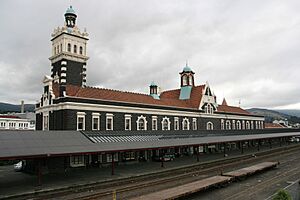Dunedin railway station facts for kids
Quick facts for kids
Dunedin railway station
|
|
|---|---|

Anzac Square and Dunedin railway station
|
|
| Location | Anzac Square, Dunedin |
| Owned by | Dunedin City Council |
| Line(s) | Main South Line |
| Platforms | 2 |
| Connections | Dunedin Railways |
| Construction | |
| Parking | Yes |
| History | |
| Opened | 1906 |
| Designated: | 1-Sep-1983 |
| Reference #: | 59 |
The Dunedin railway station is a famous building in Dunedin, New Zealand. It is on the South Island. The station was designed by George Troup. He was even nicknamed "Gingerbread George" because of its fancy design! This station is the fourth one built in the city.
Contents
Early Trains in Dunedin
Dunedin became connected to Christchurch by train in 1878. A link south to Invercargill was finished the next year. The first railway workshops, where trains were fixed, opened in 1875.
People wanted a grand main station. But for a long time, only a simple, temporary station was built in 1884. It took almost 20 years for the government to give money for a new, big station. Planning for the new station started as the 1800s ended.
Building what would become New Zealand's busiest railway station took three years. Construction began in 1903. Dunedin needed a big station because it was a busy place for business and factories. It was also close to gold and coal mines. The area around it relied on farming and forests.
How the Station Was Built
The station has a unique and fancy style. It looks like an old European building from the Renaissance period. It is made from dark basalt stone from Kokonga. Lighter Oamaru stone was used for details. This gives the building a cool light and dark pattern. You can see this pattern on many grand buildings in Dunedin and Christchurch.
Pink granite pillars stand in a line at the front of the station. The roof is covered with red terracotta tiles from France. It also has shiny copper domes on top. The south end of the station has a tall, 37-meter clocktower. You can see this clocktower from many parts of central Dunedin.
Inside, the main hall where you buy tickets is amazing. Its floor is a mosaic made of almost 750,000 tiny tiles! A beautiful porcelain design runs around the balcony above. From the balcony, you can clearly see the floor's pattern. It shows a train and other railway symbols. The main platform at the station is the longest in New Zealand. It stretches for about 500 meters.
The first stone for the station was laid on June 3, 1904. This was done by Joseph Ward, who was the Minister of Railways. The Prime Minister, Richard Seddon, was also there. The station officially opened in 1906. It was opened by Joseph Ward, who was Prime Minister by then. The building project stayed within its budget. It cost £40,000, which was a lot of money back then!
Station History
When it first opened, the Dunedin railway station was the busiest in New Zealand. It handled up to 100 trains every day! This included local trains to Mosgiel and Port Chalmers. There were also trains to Christchurch and Invercargill. Over time, fewer people used trains. So, only a few trains use the station today.
The station used to have special platforms at both ends for trains to turn around. There were also large areas for moving trains around. Most of these areas are now gone. The land has been used for other buildings.
Today, the station is used for many things, not just trains. The Dunedin City Council bought it in 1994. It still serves the Dunedin Railways tourist trains. But much of the ground floor is now a restaurant. The top floor is home to the New Zealand Sports Hall of Fame. It also houses the Otago Art Society.
Every Saturday morning, a market is held outside the station. In March each year, the station hosts a big fashion show. The main platform becomes a very long catwalk!
The outside of the station was fully cleaned and repaired in the late 1990s. The gardens outside were also made beautiful.
In October 2006, the station celebrated its 100th birthday. There was a big festival with eight steam trains from all over New Zealand. In 2006, a travel guide called it one of "The World's 200 Must-See Places."
In 2008, a train wagon hit and damaged a historic footbridge at the station. This bridge connected Anzac Square to the industrial area. Four people were on the bridge. One person had minor injuries after falling. A new bridge, looking similar to the old one, was built in late 2008.
Anzac Square and Anzac Avenue
Right outside the station is Anzac Square. Even though it's called a square, it's actually shaped like a triangle. It was redesigned in the 1990s to be a pretty garden. Across the square is Lower Stuart Street. This street leads to the city's center, The Octagon. From there, you can clearly see the station. It's a major landmark.
The square is at the start of Anzac Avenue. This is a tree-lined street about a kilometer long. It runs next to the railway. Anzac Avenue leads to Logan Park. Part of Anzac Avenue is also State Highway 88. This highway connects the city center to the port at Port Chalmers.
Logan Park was where the 1925 New Zealand and South Seas Exhibition was held. Anzac Avenue and Anzac Square were named to remember the ANZACs. These were the Australian and New Zealand soldiers who fought in the First World War. After the square was updated, a plaque for New Zealand's bravest soldiers was moved there. It is now near the city's main war memorial.
Transport Services
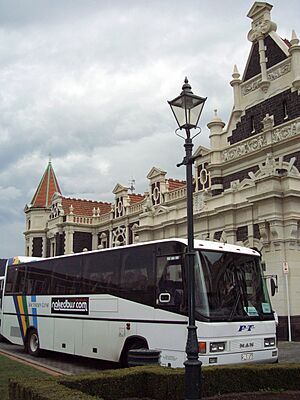
The station used to have daily sightseeing trains. These trains went to Middlemarch or Pukerangi through the Taieri Gorge. They also went to Palmerston.
Even though the station doesn't have special bus facilities, it's a main stop for buses. It's where shuttle vans go to Dunedin International Airport. Most long-distance buses also stop here. Only the Intercity bus company has its own terminal nearby.


